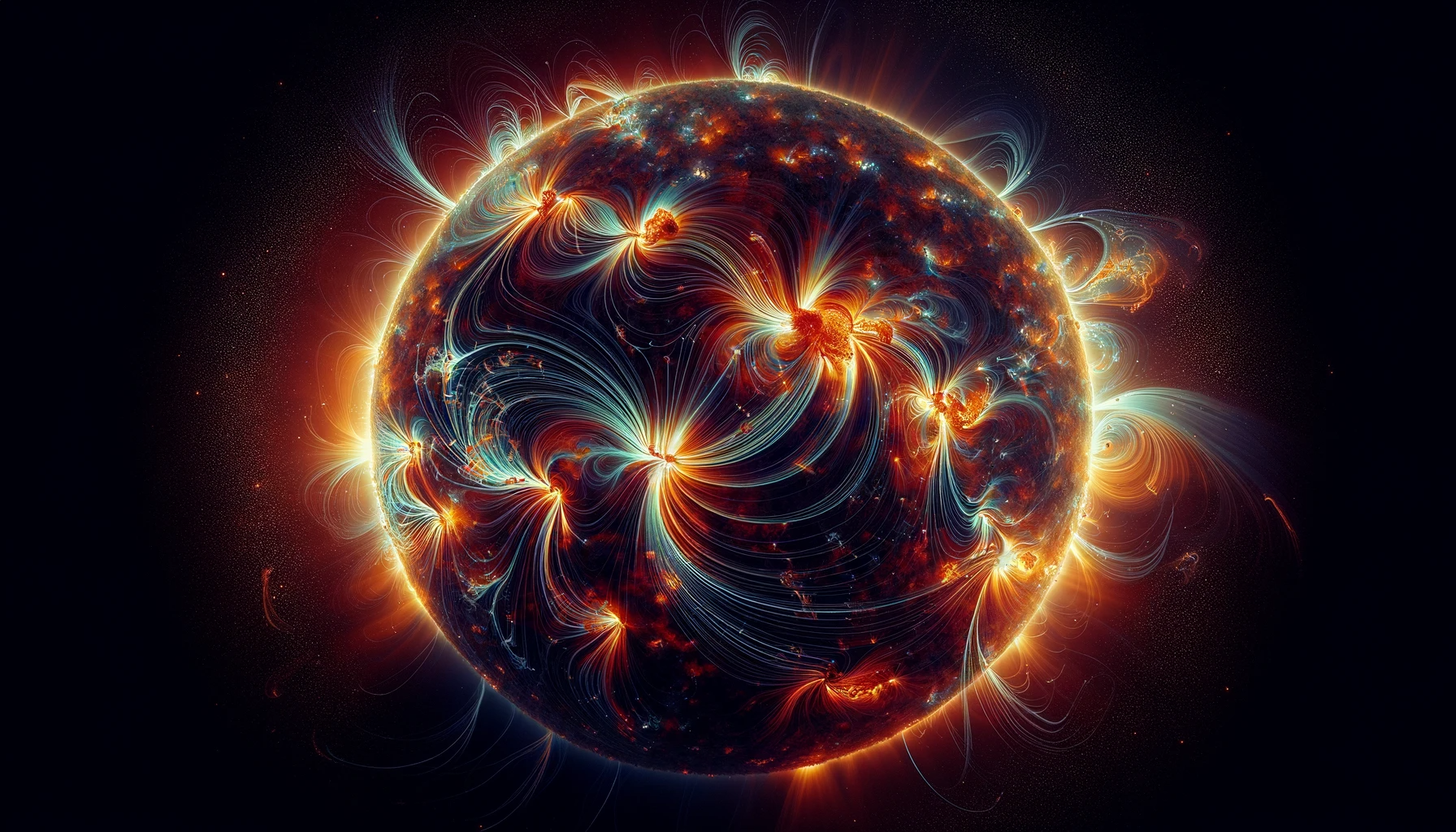In a study published in the journal Scientific Data, researchers unveiled an exceptionally comprehensive dataset encompassing more than 1.3 million solar magnetogram images, meticulously paired with corresponding solar flare records. This groundbreaking dataset could propel the advancement of machine-learning techniques designed for automated solar flare forecasting systems.
 Study: Unveiling a Comprehensive Solar Magnetogram Dataset for Advanced Flare Forecasting. Image credit: Generated using DALL.E.3
Study: Unveiling a Comprehensive Solar Magnetogram Dataset for Advanced Flare Forecasting. Image credit: Generated using DALL.E.3
The Sun exhibits dramatic eruptive events like solar flares and coronal mass ejections that can adversely impact space weather conditions around Earth and throughout the solar system. These dangerous space weather storms are linked to concentrated knots of magnetic field lines that thread through sunspots and active regions (ARs) which are visible magnetic structures on the solar surface.
National Aeronautics and Space Administration’s (NASA's) Solar Dynamics Observatory (SDO) continuously monitors the Sun from geosynchronous orbit using the Helioseismic and Magnetic Imager (HMI) instrument to image the strength and topology of the solar magnetic field. The HMI generates full-disk maps and can isolate local views of ARs using line-of-sight (LOS) magnetogram images that quantify the LOS component of the vector magnetic field.
Advanced machine learning techniques like deep convolutional neural networks have shown tremendous success across computer vision tasks and now offer intriguing new pathways to analyze such massive solar image datasets to develop automated solar flare forecasting models for operational space weather monitoring. However, existing collections of HMI magnetogram snapshots must be improved as incomplete coverage of AR evolution, arbitrarily sized image patches, or lack of definite flare occurrence labels matched to images to train and evaluate flare prediction algorithms adequately.
About the Study
A multi-institutional research team led by the New Mexico State University with contributors from the National Solar Observatory and Los Alamos National Laboratory created one of the most extensive and most valuable datasets to date comprising 1.37 million LOS photospheric magnetogram images tracking 1,655 ARs from NASA's SDO/HMI instrument spanning nine years from May 2010 to December 2018.
The project integrated AR information like initial appearance dates, locations, and lifetimes recorded in NOAA's space weather event summaries to precisely track SDO pointing and capture 600 x 600 pixel HMI snapshots covering each AR at 12-minute intervals throughout their evolution across the solar disk. Concurrent records detailing the peak times and strengths of over 190,000 solar flares were parsed from NOAA's GOES x-ray flux archive and matched to the AR magnetogram images to provide vital supervised labels for developing solar flare forecasting machine learning models. Latitude/longitude metadata filtered out off-limb AR images strongly affected by distortions from the spherical projection.
Salient Highlights of the New Dataset
- Unprecedented scale covers two complete solar cycles (cycles 23/24) with over 1.37 million images densely sampling AR evolution at a 12-minute cadence.
- 75/15/10 percent random partitions for training, validation, and testing to enable standardized benchmarking as new algorithms are developed
- User-configurable flare thresholds and temporal flare prediction windows
- 29 magnetic complexity features (gradients, neutral lines, wavelets, fluxes) quantified for each 600 x 600-pixel image
- 375 GB full-resolution FITS and 15 GB reduced 224 x 224 pixel 8-bit PNG options
- Integrates multi-source metadata matching SDO images with NOAA flare detections
Results and Applications
In essential validation trials, the researchers first demonstrated that conventional machine learning using the suite of 29 image-derived magnetic features fed into a support vector machine model achieved solar flare prediction skills comparable to a prior magnetogram analysis study based on different imagery, confirming the broad utility of the dataset. Additional experiments applying VGG16 transfer learning to the images as inputs showed flare prediction performance on par with the magnetic complexity features.
Looking ahead, the public release of this expansive new visually rich solar physics dataset integrating coordinated multi-source information opens the door for extensive studies applying state-of-the-art deep learning architectures and computer vision techniques to decisively improve fundamental understanding of how intricate magnetic field structures evolve to trigger flares and realize the practical goal of highly accurate automated solar flare forecasting systems needed for robust real-time space weather monitoring and mitigation.
Future Outlook
The innovative multi-stage approach employed by the researchers has created an extensive and invaluable dataset, serving as a crucial resource for future endeavors in solar physics and space weather prediction. The dataset, meticulously constructed from over 1.3 million solar magnetogram images paired with solar flare records, opens avenues for advanced studies utilizing cutting-edge deep learning architectures and computer vision techniques.
By leveraging data from the Space Weather Prediction Center (SWPC) and Joint Science Operations Center, the researchers have established a foundation for exploring intricate magnetic field structures and their role in triggering solar flares. The dataset, spanning the years 2010-2018, provides a temporal evolution of solar activity, facilitating comprehensive investigations into the dynamics of the Sun.
During dataset curation, which involved removing distorted limb images and utilizing latitude/longitude metadata, geometric constraints were applied to ensure the dataset's quality and relevance. This rich resource, divided into training, validation, and test sets, aligns with best practices in machine learning workflows, enabling researchers to develop and validate models effectively.
Moreover, the demonstrated success of machine learning models, such as the support vector classifier and the adapted VGG16 convolutional neural network (CNN) architecture, underscores the dataset's potential impact. Achieving skill scores comparable to existing magnetogram studies, these models showcase the dataset's utility in advancing our fundamental understanding of solar phenomena.
Looking ahead, the dataset paves the way for the refinement and development of highly accurate automated solar flare forecasting systems. With real-time space weather monitoring and mitigation becoming increasingly critical, this visually rich dataset stands as a benchmark for continually enhancing machine learning algorithms, ultimately contributing to predicting hazardous space storms with unprecedented precision and reliability.
Journal reference:
- Boucheron, L. E., Vincent, T., Grajeda, J. A., & Wuest, E. (2023). Solar active region magnetogram image dataset for studies of space weather. Scientific Data, 10(1), 825. https://doi.org/10.1038/s41597-023-02628-8, https://nature.com/articles/s41597-023-02628-8